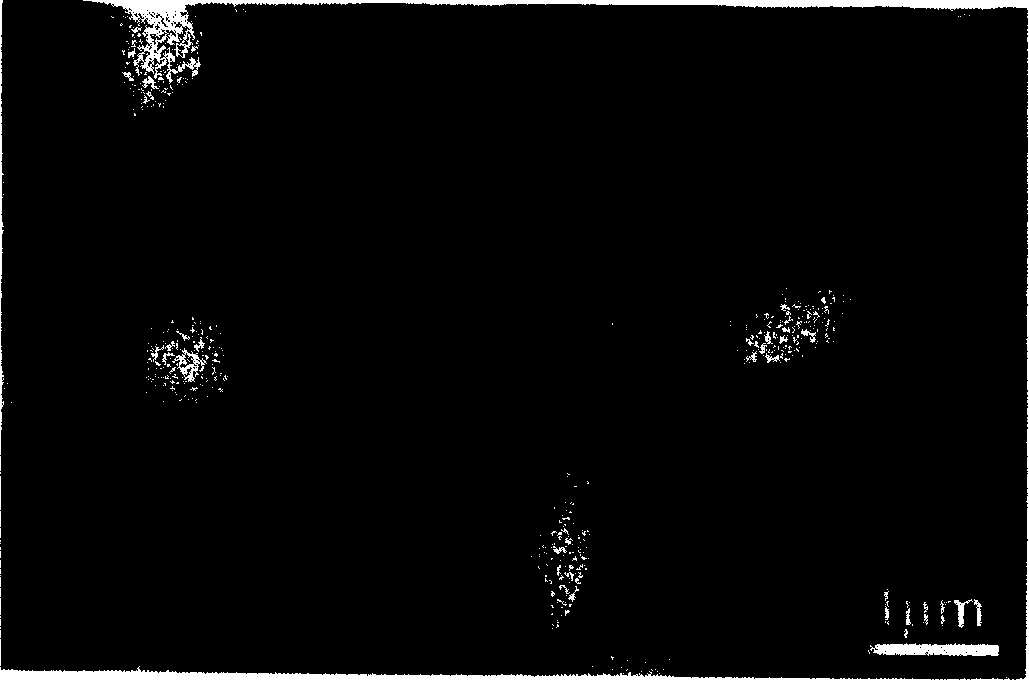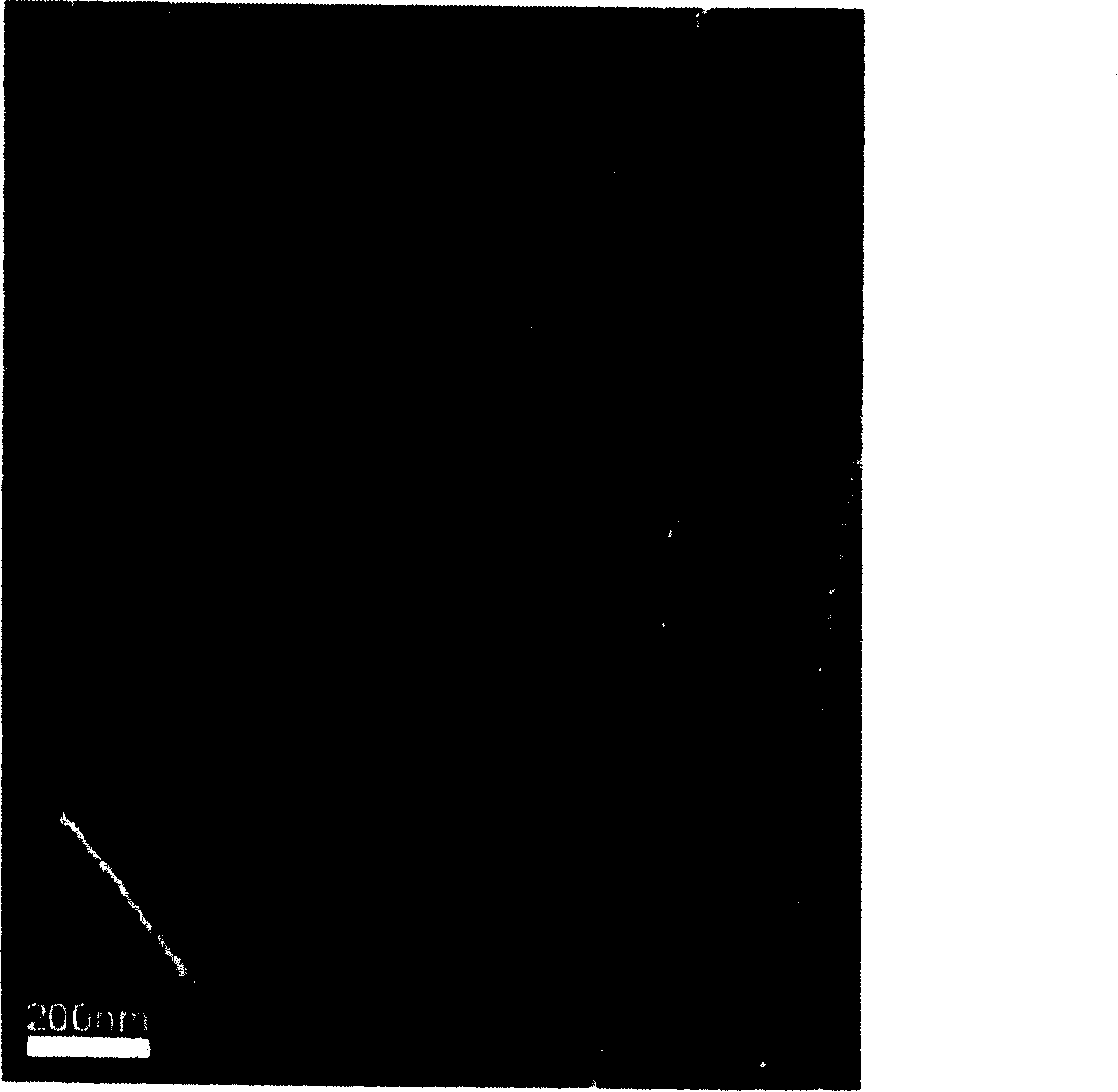Functional polymer nano composite material and preparation method and uses thereof
A nano-composite material and composite material technology, applied in the field of functional polymer nano-composite materials, can solve the problems of antibacterial function and other problems, and achieve the effect of controllable function, simple equipment and convenient performance
- Summary
- Abstract
- Description
- Claims
- Application Information
AI Technical Summary
Problems solved by technology
Method used
Image
Examples
Embodiment 1
[0032] (1) 0.63g of polyethylene terephthalate (PET) was dissolved in 3ml of a mixed solvent of trifluoroacetic acid and dichloromethane (v:v=1); 1ml of tetra-n-butyl titanate was added to 3ml of three In a mixed solvent of fluoroacetic acid and dichloromethane (v: v=1), after magnetically stirring at room temperature for 3 hours, mix the two, continue stirring for 30 minutes, and then add them into the needle tube of the electrospinning nozzle;
[0033] (2) Control the voltage between the spinneret of the electrospinning equipment and the collecting plate at 30kV, and collect the electrospun fibers with an aluminum foil plate. Air-dry the obtained electrospun fiber at room temperature for 24 hours, evaporate the solvent, then immerse in pure water at 70°C for 10 hours, take it out and dry it, and you can get the TiO-containing 2 PET / TiO with a particle size of 3nm 2 Photocatalytic nanocomposites. Scanning electron microscope photos as figure 1 shown.
Embodiment 2
[0035] (1) 0.63g polyethylene terephthalate (PET) is dissolved in 1ml trifluoroacetic acid and dichloroethane mixed solvent (v:v=1); 1ml tetra-n-butyl titanate is added to 2ml In the mixed solvent (v:v=1) of trifluoroacetic acid and dichloroethane, after magnetically stirring at room temperature for 3 hours, the two were mixed, and then added to the needle tube of the electrospinning nozzle after continuing to stir for 30 minutes;
[0036] (2) Control the voltage between the spinneret of the electrospinning equipment and the collecting plate at 30kV, and collect the electrospun fibers with an aluminum foil plate. Air-dry the obtained electrospun fiber at room temperature for 24 hours, evaporate the solvent, then immerse in pure water at 90°C for 15 hours, take it out and dry it, and you can get the TiO-containing 2 PET / TiO with a particle size of 3.7nm 2 Photocatalytic nanocomposites. Scanning electron microscope photos as figure 2 shown.
Embodiment 3
[0038] (1) 0.63g of polyethylene terephthalate (PET) was dissolved in 5ml of a mixed solvent of trifluoroacetic acid and dichloromethane (v:v=1); 1ml of tetra-n-butyl titanate was added to 1ml of three In the mixed solvent of fluoroacetic acid and dichloromethane (v: v=1), after magnetic stirring at room temperature for 3 h, mix the two, add 300 μL of chloroplatinic acid with a concentration of 0.05 mol / L, continue stirring for 30 min, and then add to the electrospinning In the needle tube of the silk nozzle;
[0039] (2) Control the voltage between the spinneret of the electrospinning equipment and the collecting plate at 30kV, and collect the electrospun fibers with an aluminum foil plate. Air-dry the obtained electrospun fibers at room temperature for 24 hours, and then undergo 300W microwave radiation for 3 minutes at a radiation frequency of 2 GHz to obtain TiO-containing fibers. 2 Particle size at 3nm, PtO 2 The mass percentage is 0.39% PET / TiO 2 Photocatalytic nanoco...
PUM
 Login to View More
Login to View More Abstract
Description
Claims
Application Information
 Login to View More
Login to View More - R&D
- Intellectual Property
- Life Sciences
- Materials
- Tech Scout
- Unparalleled Data Quality
- Higher Quality Content
- 60% Fewer Hallucinations
Browse by: Latest US Patents, China's latest patents, Technical Efficacy Thesaurus, Application Domain, Technology Topic, Popular Technical Reports.
© 2025 PatSnap. All rights reserved.Legal|Privacy policy|Modern Slavery Act Transparency Statement|Sitemap|About US| Contact US: help@patsnap.com


